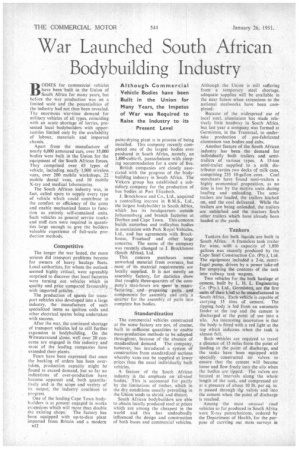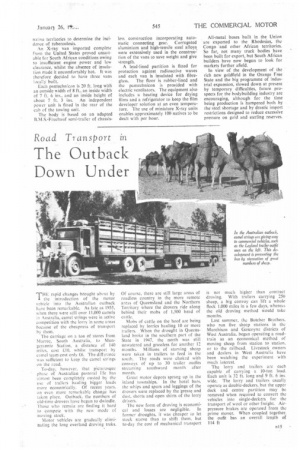War Launched South African Bodybuilding Industry
Page 46

Page 49

If you've noticed an error in this article please click here to report it so we can fix it.
Although. Commercial Vehicle Bodies have been Built in the Union for Many Years, the Impetus of War was Required to Raise the Industry to its Present Level
BODIES for commercial vehicles have been 'built in the Union of South Africa for many years, but before the war production was on a limited scale and the potentialities of the industry had not then been revealed. The enormous war-time demand for military vehicles of all types, coinciding with an acute shortage of lorries, presented local bodybuilders with opportunities limited only by the availability of labour, materials and imported chassis.
Apart from the manufacture of nearly 6,000 armoured cars, over 35,000 bodies were built in the Union for the equipment of the South African forces. They comprised over 65 types of vehicle,including nearly 1,000 wireless vans, over 200 mobile workshops, 22 mobile dental vans, and 10 mobile X-ray and medical laboratories.
The South African industry was, in fact, called upon to supply every type of vehicle which could contribute to the comfort or efficiency of the army and enable mechanized forces to function as entirely self-contained units. Such vehicles as general service trucks and staff cars were required in quantities large enough to give the builders valuable experience of full-scale production methods.
Competitive
The longer the war lasted, the more serious did transport problems become for owners of heavy haulage fleets. Local authorities, for whom the outlook seemed highly critical, were agreeably surprised to discover that local factories were turning out vehicles which in quality and price compared favourably with imported articles.
The production of spares for transport vehicles also developed into a large industry, the manufacture of such specialized items as ignition coils and other electrical spares being undertaken with success.
After the war, the continued shortage of transport vehicles led to still further expansion in bodybuilding. On the Witwatersrand alone, well over 20 concerns are engaged in this industry and most of the leading companies have extended their plants.
Fears have been expressed that once the backlog of orders has been overtaken, production capacity might be found to exceed demand, but so far no indications of over-production have become apparent and, both quantitatively and in the scope and variety of its output, the industry continues to progress.
One of the leading Cape Town bodybailders is at present engaged in works extensions which will more than double the existing shops.' The factory has been equipped with up-to-date plant imported from Britain and a modern til2 paint-drying plant is in process of being installed. This company recently completed one of the largest bodies ever produced in South Africa, namely, an 1,800-cubic-ft. pantechnicon with sleeping accommodation for a crew of five.
British companies are closely associated with the progress of the bodybuilding industry in South Africa. The Vickers group has established a subsidiary.company for the production of bus bodies at Port Elizabeth.
J. Brockhouse and Co., Ltd., acquired a controlling interest in B.M.S., Ltd., the largest bodybuilder in South Africa, which has its headquarters outside Johannesburg and branch factories at Durban and ape Town. This concern builds motorbus and trolieybus bodies in association with Park Royal Vehicles, Ltd., and has agreements with Brockhouse, Fruehauf and other large concerns. The name of the company was recently changed to J. Brockhouse (South Africa), Ltd.
This concern purchases some unworked material from overseas, but most of its material requirements are locally supplied. It is not merely an assembly factory, for statistics show that roughly three-quarters of the company's man-hours are spent in manufacturing andpreparing •parts and components for assembly and only a quarter for the assembly of parts into complete bus bodies.
Standardization The commercial vehicles constructed at the same factory are not, of course, built insufficient quantities to enable mass-production methods to be adopted throughout, because of the absence of standardized demand. The company, however, has introduced a system of construction from standardized sections whereby vans can be supplied at lower prices than the usual individually built vehicles.
A feature of the South African industry is the emphasis on all-steel bodies. This is accounted for partly by the limitations of timber, which in the dry conditions usually prevailing in the Union tends to shrink and distort.
South African bodybuilders are able to obtain locally produced steel at prices which are among the cheapest in the world and this has undoubtedly influenced the design and construction of both buses and commercial vehicles. Although the Union is still suffering from a temporary steel shortage, adequate supplies will be available in the near future when extensions to the national steelworks have been completed.'
Because of the widespread use of local steel, aluminium has made relatively little headway in South Africa, but last year a company was formed at Germiston, in the Transvaal, to undertake production of pre-fabricated aluminium van bodies and cabs.
Another feature of the South African industry has been the demand for individually built trailers and semitrailers of various types. A 15-ton semi-trailer supplied to a milk distributor carries two decks of milk cans, comprising 235 10-gallon cans. Coal merchants have found semi-trailers a highly economical proposition, as no time is lost by the motive units during loading and unloading. The semitrailers are loaded, the trailers hitched on, and the coal delivered. While the trailers are being unloaded, the trailers are unhitched and the tractors fetch other trailers which have already been loaded at the yards.
Tankers
Tankers for bulk liquids are built in South Africa. A frameless tank trailer for wine, with a capacity of 1,800 gallons was recently produced by the Cape Steel Construction Co. (Pty.), Ltd. The equipment included a 2-in, centrifugal pump, driven by a power take-ofl for emptying the contents of the tank into railway tank wagons.
Two vehicles for the bulk haulage of cement, built by L. H. L. Engineering Co. (Pty.). Ltd. Germiston, are the first units of their kind to be manufactured in South Africa. Each vehicle is capable of carrying 15 tons of cement. The tipping body is fed from an automatic feeder at the top and the cement is discharged at the point of use into a silo. An interesting innovation is that the body is fitted with .a red light at the top which indicates when the tank is almost full.
Both vehicles are required to travel a distance of 15 miles from the point of loading to the point of discharge, and the tanks have been equipped with specially constructed air valves to ensure that the cement will become loose and flow freely into the silo when the bodies arc tipped. The valves are located at intervals along the whole length of the tank, and compressed air at a pressure of about 10 lb. per sq. in. is passed through tile valves and into the cement when the point of discharge is reached.
Among the most unusual road vehicles so far produced in South Africa were X-ray pantechnicons, ordered by the Department of Health, for the purpose of carrying out mass surveys in native territories to determine the incidence of tuberculosis.
An X-ray van imported complete from the United States proved unsuitable for South African conditions owing to insufficient engine power and low clearance, whilst the absence of insulation made it uncomfortably hot. It was therefore decided to have three vans locally built.
Each pantechnicon is 20 ft. long with an outside width of 8 ft., an inside width of 7 ft. 6 ins., and an inside height of about 7 ft. 3 ins. An independent power unit is fitted in the rear of the cab of the towing unit.
The body is based on an adapted B.M.S.-Fruehauf semi-trailer of chassis
less construction incorporating automatic connecting gear. Corrugated aluminium and high-tensile steel alloys were extensively used in the construction of the vans to save weight and give strength.
A lead-lined partition is fitted for protection against radioactive waves and each van is insulated with fibre
glass. The floor is rubber-lined and the pantechnicon is provided with electric ventilators. The equipment also includes a heating device for drying films and a refrigerator to keep the film developer solution at an even temperature. The use of miniature X-ray units enables approximately 100 natives to be dealt with per hour. All-metal buses built in the Union are exported to the Rhodesias, the Congo and other African territories. So far, not many truck bodies have been built for export, but South African builders have now begun to look for markets further afield.
In view of the development of the rich new goldfield in the Orange Free State and the big programme of industrial expansion, slowed down at present by temporary difficulties, future prospects for the bodybuilding industry are encouraging, although for the time being production is hampered both by the steel shortage and by drastic import restrictions designed to reduce excessive pressure on gold and sterling reserves.




















































































